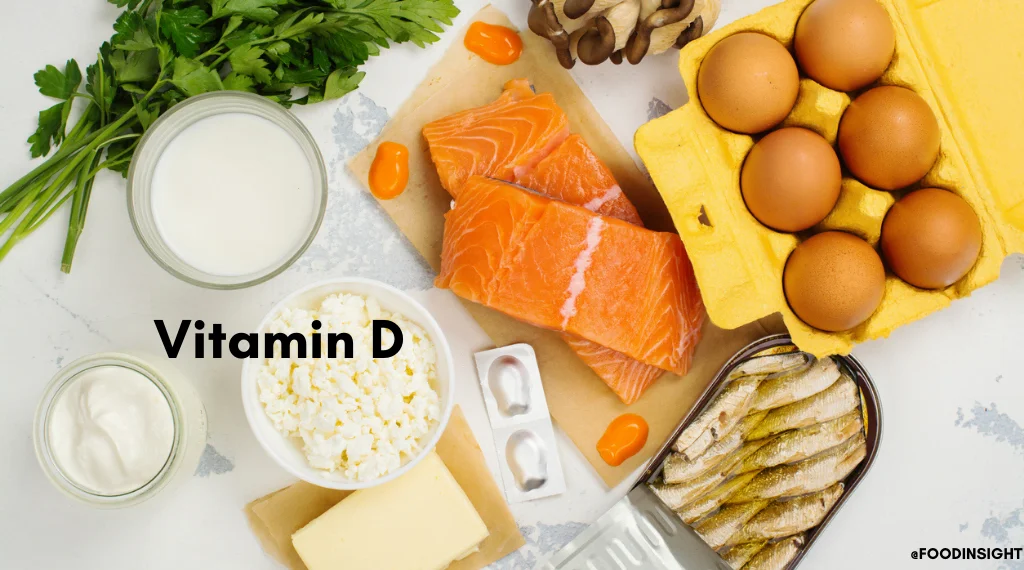
Highlights
- Vitamin D is well-known for its critical role in bone health. It’s also an important component of the muscular, nervous and immune systems.
- Its role in the prevention and treatment of many health conditions has been studied, but its most consistent benefits continue to be tied to bone health.
- Vitamin D can be consumed through food and dietary supplements, and human bodies can also make it through sun exposure.
- Vitamin D is not naturally found in most foods. Foods and beverages fortified with vitamin D, like milk, milk alternatives, breakfast cereals and juices are the major sources of vitamin D in the U.S.
The Basics
Vitamin D is a fat-soluble vitamin that also functions as a hormone in our bodies. It plays a critical role in building and maintaining skeletal health, since it helps the body absorb calcium and maintain appropriate concentrations of calcium and phosphorus, two of the primary minerals in bone. It’s also important for muscle function, helping nerves carry signals throughout the body and supporting the immune system. Vitamin D’s effect on preventing and treating a variety of health conditions is being actively studied, though no benefits have emerged as strongly as its role in preventing osteoporosis, osteomalacia and rickets (see “Vitamin D and Health,” below).
Humans can get vitamin D in three ways: eating certain foods, taking dietary supplements and making it in our skin after sun exposure. When ultraviolet (UV) light from the sun comes in contact with the skin, vitamin D synthesis is triggered. However, this form of vitamin D is inactive and needs to undergo two activation steps before being used by the body. The amount of active vitamin D in our body is tightly regulated, so blood measurements of vitamin D status often measure the concentration of a form of inactive vitamin D known as 25(OH)D. The amount of 25(OH)D in the blood accounts for vitamin D consumed through foods and supplements as well as vitamin D made in the skin.
Vitamin D and Health
There is conclusive evidence that vitamin D plays an indispensable role in bone health. Long-term vitamin D deficiency leads to bone softening, known as rickets in children and osteomalacia in adults. Insufficient vitamin D can also contribute to osteoporosis, a loss in bone density that results in brittle bones that are prone to breaking.
Because it is involved in so many systems in the human body, vitamin D continues to be actively studied as a potential treatment or preventive tool for many health conditions, including cancer, cardiovascular disease, type 2 diabetes, depression and many others. While research on all of these areas continues, thus far the evidence does not support a strong benefit of vitamin D consumption for prevention or treatment of these conditions.
Recommended Intakes
The National Academies of Sciences, Engineering and Medicine have set dietary reference intakes (DRIs) for vitamin D. These recommended dietary allowances (RDAs) differ by age, but do not differ by sex or life stage (e.g., pregnancy and lactation). Even though sunlight can be a source of vitamin D, these RDAs take a conservative approach and assume that exposure to the sun is minimal. There is not enough available research to support an RDA for infants ages 0–12 months, so an Adequate Intake (AI) has been set based on the amount of vitamin D that maintains blood 25(OH)D levels above 20 nanograms per milliliter (ng/mL) and supports bone development. DRIs are often expressed as micrograms (mcg) or international units (IU); 1 mcg is equal to 40 IU. Most people in the U.S. do not consume the recommended amount of vitamin D.
Table 1. Recommended Dietary Allowances (RDAs) for Vitamin D (in micrograms (mcg) and international units (IU))
| Age | Male | Female | Pregnancy | Lactation |
| 0–12 months* | 10 mcg (400 IU) | 10 mcg (400 IU) | ||
| 1–13 years | 15 mcg (600 IU) | 15 mcg (600 IU) | ||
| 14–18 years | 15 mcg (600 IU) | 15 mcg (600 IU) | 15 mcg (600 IU) | 15 mcg (600 IU) |
| 19–50 years | 15 mcg (600 IU) | 15 mcg (600 IU) | 15 mcg (600 IU) | 15 mcg (600 IU) |
| 51–70 years | 15 mcg (600 IU) | 15 mcg (600 IU) | ||
| >70 years | 20 mcg (800 IU) | 20 mcg (800 IU) |
*Adequate Intake (AI)
Table Source: The Health and Medicine Division of the National Academies of Sciences, Engineering and Medicine
Since getting enough vitamin D through food sources can be difficult, there are several groups of people who are at risk of having inadequate vitamin D stores. These include older adults, people with limited sun exposure, people with dark skin, those with health conditions that limit vitamin D absorption (such as celiac disease, inflammatory bowel disease and cystic fibrosis) and people who have had gastric bypass surgery. People who are obese (body mass index > 30 kg/m2) often have serum 25(OH)D levels that are lower than people who are not obese, because body fat can sequester vitamin D.
Breastfed infants are also at higher risk for inadequate vitamin D, because breast milk is not a good source and it is advised to protect infants from sun exposure. To reduce risk for vitamin D deficiency in infants, the American Academy of Pediatrics recommends that exclusively and partially breastfed infants be given 10 mcg (400 IU) vitamin D supplements per day until they are able to consume 1000 milliliters of vitamin D-fortified formula or whole cow’s milk per day. Unfortunately, compliance with this guideline is low: only one in five breastfed infants meets this level of supplementation.
Tolerable upper intake levels (ULs) have also been established for vitamin D because it is possible to consume too much of it. This condition is most common in people who overconsume vitamin D supplements. High vitamin D intake can cause vomiting, diarrhea, constipation, dry mouth, loss of appetite and a metallic taste. Consistently excessive vitamin D intake can also lead to over-calcification of bones and hardening of blood vessels and organ tissues. Excessive sun exposure is not believed to cause vitamin D toxicity due to the body’s ability to regulate its formation of vitamin D.
Food Sources of Vitamin D
Vitamin D is naturally found in relatively few foods; these include fatty fish, egg yolks, liver and mushrooms. In contrast, meat, poultry, whole grains, fruits and vegetables contain little to no vitamin D. Fortified foods—in particular, cow’s milk, breakfast cereals and juices—are major sources of vitamin D in the American diet. Plant-based milk alternatives, such as oat-, soy- and almond-based beverages are also often fortified with vitamin D. In the U.S., infant formula is required to contain 1–2.5 mcg (40–100 IU) vitamin D per 100 calories.
Table 2. Food Sources of Vitamin D
| Food | Serving size | Vitamin D content (mcg [IU]) |
| White mushrooms, raw, exposed to UV light to increase levels of vitamin D | ½ cup sliced | 18.3 (732) |
| Rainbow trout, cooked | 3 ounces | 16.2 (648) |
| Sockeye salmon, cooked | 3 ounces | 14.2 (568) |
| Soy-based milk, vitamin D-fortified | 1 cup | 2.7 (108) |
| Milk, 2%, vitamin D-fortified | 1 cup | 2.9 (116) |
| Ready-to-eat cereal, fortified with 10% of the daily value for vitamin D | 1 serving | 2.0 (80) |
| Light tuna fish, canned in water | 3 ounces drained | 1.7 (68) |
| Oat-based milk, vitamin D-fortified | 1 cup | 1.5 (60) |
| Scrambled egg | 1 large egg | 1.1 (44) |
| Beef liver, braised | 3 ounces | 1.0 (42) |




